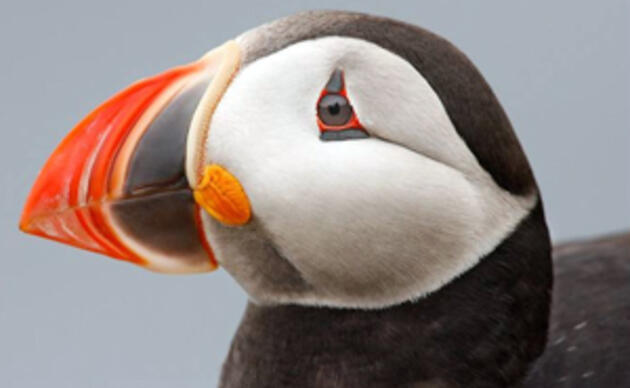Surprising migration takes puffins north to the Gulf of St. Lawrence and then south to underwater “coral canyons and seamounts” off New England
Until this summer, the winter home of Maine puffins was largely unknown, but that has suddenly changed with revelations discovered this year.
The background leading up to this year’s discovery demonstrates the value of perseverance. In 2011, two first generation puffin geolocators were recovered from birds tagged at Seal Island National Wildlife Refuge in 2009 (geolocators do not transmit data and require recapture of the bird to download data). The tags revealed a northward journey after the nesting season to the Gulf of St. Lawrence and north to the Labrador Sea, before a southward movement to the edge of the continental shelf for the remainder of the winter. This was big news--the first hint of the puffin’s then mysterious winter home. But these were just two birds and neither bird nested in subsequent years. This aroused suspicion that winter movements also could have been affected by the devices.
The quest for the puffin’s winter range continued in 2010-2012 when 38 smaller, new generation tags were attached to puffin leg bands. Although 30 of these were recovered and puffin behavior appeared normal, none contained data because of manufacturing defects. Despite this huge disappointment, 26 improved tags were attached to puffins in 2013 and 2014. By the summer of 2015, 20 of these were recovered and 17 contained useful data. These tags revealed a remarkable story.
The tagged puffins travelled northward in August to the western Gulf of St. Lawrence--a region known for abundant forage fish. The geolocators also showed that as days shortened, the puffins began heading south to the U.S. continental shelf--well offshore from New York and New Jersey where they spent the rest of the winter--before arriving back in Maine by early April. The exact routes remain a mystery.
The areas most frequented during the winter months were about 200 miles southeast of Cape Cod—including an area known as New England’s “coral canyons and seamounts.” This vast, largely unexplored area includes canyons deeper than the Grand Canyon, along with submerged mountains (seamounts) noted for colorful corals, some as large as small trees. Puffins are likely attracted to the region because of productive upwelling currents that offer abundant food--the same conditions that favor whales, porpoise, tuna, sailfish, and seabirds. Cashes Ledge, another underwater mount inside the Gulf of Maine, was also popular with puffins as it is for whales and other sea-life. The discovery that puffins winter over these canyons and seamounts provides another reason to protect these areas from fishing, mining, and energy development. An initiative is now underway to protect these important areas as the first Atlantic marine national monument in the United States. These discoveries were first shared by Project Puffin biologists this past week with a poster presentation at the 43 annual meeting of the Pacific Seabird Group.
This research was made possible by donations from Project Puffins supporters, especially Bill and Maryanne Perks, Shirley Egan and the late Robert Wanner.
To donate to Project Puffin, click HERE.
UPDATE: We sent out an eNews bulletin in June 2016 asking for assistance in protecting Maine puffins. We are happy to announce that with your help, this letter was finalized in late June, and mailed to President Obama for his consideration. A GREAT BIG THANK YOU goes out to all who helped with this important campaign!
Learn about birds and take action
Adopt-A-Puffin
Adopt now and receive a Certificate of Adoption, along with a biography of "your" puffin!
Visitor Center
The Project Puffin Visitor Center (PPVC) is located at 311 Main Street in downtown Rockland, Maine. The center opened its doors officially on July 1, 2006.



